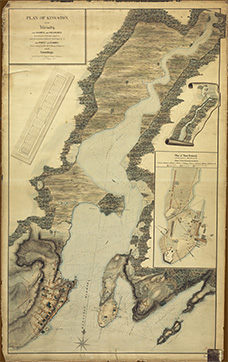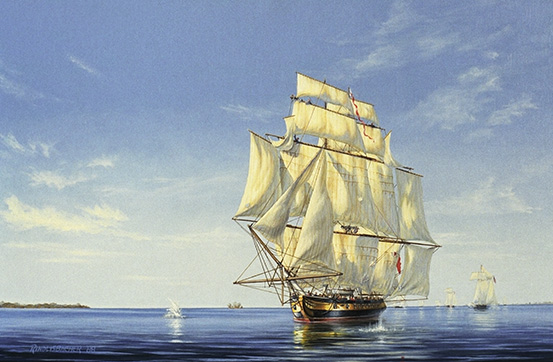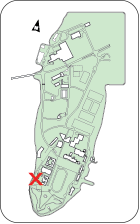In July 1812, Master and Commander Hugh Earl of the Provincial Marine Corvette Royal George (22 guns and launched 3 years earlier), had attacked Sackets Harbor. Five months later, in November, an American fleet of seven ships under Commodore Isaac Chauncey sailed to the Bay of Quinte area determined first to capture the largest British ship on Lake Ontario, the Royal George and to harass merchant shipping, then to destroy the Kingston Dockyard. In spite of light winds and a determined enemy in pursuit, the Royal George escaped, arriving the next day safely in Kingston's inner harbour. Chauncey had attacked her all the way there, but after encountering vigorous gun fire from both Royal George and the Point Frederick and Mississauga shore batteries, he failed to press home his attack and withdrew.
 Contemporary sketch map of the shores and measures in the vicinity of Kingston from a survey by Lieutenant H.L. Renny, RE, and soundings by Acting Lieutenant W. Bayfield, RN. Fortifications and buildings are illustrated on both Points Frederick and Henry. Inset illustrates the proposed alterations for the dockyard.
Contemporary sketch map of the shores and measures in the vicinity of Kingston from a survey by Lieutenant H.L. Renny, RE, and soundings by Acting Lieutenant W. Bayfield, RN. Fortifications and buildings are illustrated on both Points Frederick and Henry. Inset illustrates the proposed alterations for the dockyard.
 Painting: Flight of the Royal George in light winds with all sail set being pursued by American schooners on 10 November 1812 before gaining the protection of her port and shore batteries. Courtesy of the artist, Peter Rindlisbacher. This painting is part of the collection at the Marine Museum of the Great Lakes in Kingston.
Painting: Flight of the Royal George in light winds with all sail set being pursued by American schooners on 10 November 1812 before gaining the protection of her port and shore batteries. Courtesy of the artist, Peter Rindlisbacher. This painting is part of the collection at the Marine Museum of the Great Lakes in Kingston.
While he likely intended to exploit his dominant position on Lake Ontario the following year, it did not happen. In early 1813, the British abandoned pre-war plans to move their naval base to the safer position of York, and the quick build-up of Kingston's defences coupled with major warship construction was clear recognition of the strategic importance of the site and a willingness to defend it.
Walking Tour

 Panel 7 is located on the water-side of the gazebo in front of Fort Champlain, a dormitory located at 2 Point Frederick Drive, and is sited toward Kingston's inner harbour, where the Royal George sought refuge. The gazebo was a gift from the Class of 1966.
Panel 7 is located on the water-side of the gazebo in front of Fort Champlain, a dormitory located at 2 Point Frederick Drive, and is sited toward Kingston's inner harbour, where the Royal George sought refuge. The gazebo was a gift from the Class of 1966.